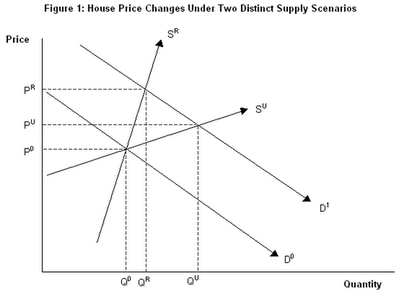Via the AFR:
Immigration cuts planned by the Morrison and NSW governments will weaken house prices, according to analysis by the state government and economists.
Housing Prices and Migration Flows, a NSW Treasury document obtained by The Australian Financial Review, shows Sydney and national house prices would be lower than the forecast trajectory due to fewer migrants.
Under one scenario modelled, a temporary reduction in annual net overseas migration to Australia of 64,000 over five years would cause national house prices to be 7.8 per cent lower and NSW house prices to be 6.8 per cent weaker than a business-as-usual “baseline”.
In trend terms that is right. But it is a little more complex. In Australia’s supply constrained market adding such demand does not just lift prices, it lifts volatility. Supply constrained markets overshoot to the upside and the down more easily because so do lagged supply responses. Such a situation can be explained using basic supply and demand analysis, as shown in Figure 1.
Q0 and P0 represent the initial equilibrium situation in the housing market. Initial demand is provided by D0, whereas supply is shown as either SR (restricted) or SU(unrestricted), depending on whether land supply constraints exist.
Following an increase in demand, such as a surge of investors following changes to tax rules (e.g. Australia’s CGT reduction in 1999), the demand curve shifts outwards from D0 to D1. When land supply is restricted, house prices rise sharply from P0 to PR. By contrast, when supply is unrestricted, prices rise more gradually from P0 to PU.
The situation works the same way in reverse. For example, if there was a sharp fall in demand following a contraction in credit availability or a sharp decrease in Australia’s Terms of Trade, causing demand to fall from D1 to D0, then prices fall much further when land supply is constrained.
The key point of this analysis is to show that declines in demand can bring sharply falling house prices even when supply is constrained and housing shortages exist.
Australia has not seen such booms and busts only owing to compulsive policy interference in 2003, 2009, 2012 and, soon enough, 2019. But as those tools are exhausted, the busts will get worse.
And, of course, there is also the longer balance sheet cycle to worry about. When debt saturation reaches some critical point that means deleveraging takes over during one such bust, destroying the market for generations.
Only a fool would stuff Australian housing with endless lines of people.


